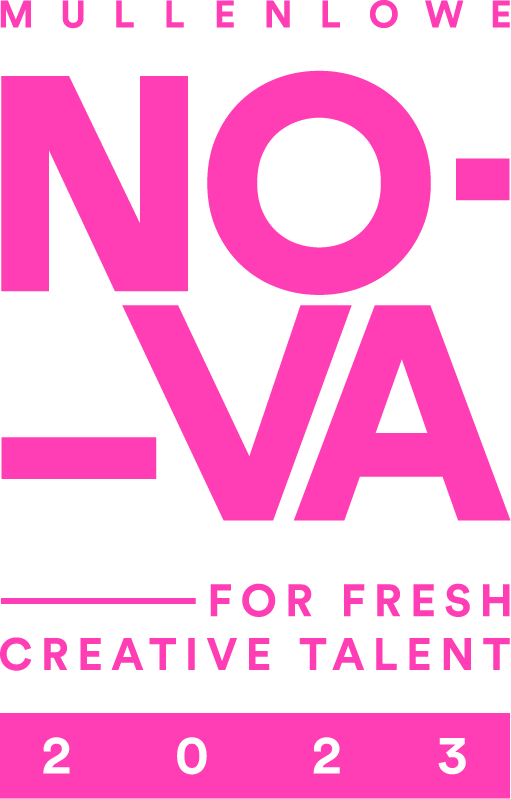The Strange And Wonderful Shortlist

The projects in MullenLowe Group’s partnership with Central Saint Martins range from a practical product to tackle period poverty faced by refugees, to a moss dress and a home meat-making machine. MullenLowe Group’s creative chief Jose Miguel Sokoloff speaks to Campaign UK about what adland can learn from the diverse pool of ideas.
Now in its 10th year, the MullenLowe NOVA Awards celebrate the best ideas from graduating students at London’s Central Saint Martins. From 1,300 entries, 49 were nominated, and these have now been whittled down to 14 shortlisted ideas, which you can read about below.
From the shortlist, six awards will be announced at an online ceremony on 18 August: a winner, two runners-up, and three special awards. These are the Unilever #Unstereotype Award, the Creative Boom “Conscious” Award, and the YourNOVA Award, a “People’s Choice” that is voted for by the public. You can cast your vote for that here.
The shortlisted students come from product design, fashion design, industrial design, fine art, graphic communication design, performance: design and practice, art and science, material futures, and biodesign, and their ideas are just as varied as you might expect.
Campaign spoke to Jose Miguel Sokoloff, global president of MullenLowe Group’s creative council, and one of the ten judges, to find out what adland can learn from these diverse entries.
Campaign: What are the MullenLowe NOVA Awards, and why is it something MullenLowe Group chooses to support?
JMS: The MullenLowe NOVA Awards are a partnership we’ve had with Central Saint Martins for over 10 years now. The idea is to reward, and somehow give more notoriety and visibility to those students that are presenting extraordinary graduation projects that really transcend the boundaries of thinking, creativity and questioning. They are ideas that are moving us forward as nations and in some cases as humanity. It’s incredibly interesting how these projects really surprise you all the time. This is young, unfiltered thinking where so many ideas come from.
It’s our attempt to see these ideas early on, to learn from them and participate in them. We want try to stimulate the students with outstanding ideas and give them some funds so that they can continue with their practice and their research, and feel that what they’re doing is the right thing.
What kinds of things do you look for when you’re assessing the best entries?
I’m looking to be surprised, awed and taken aback. There’s a trend this year, that instead of looking for answers, the students are using different elements of creativity such as product design, video, soundscapes or even fashion, to make us question the way we live.
Sometimes I’m impressed by the brilliantness of the solution to a problem that’s always been there. Sometimes the genius is in the process – how intricate, detailed, profound and deep the process was to find the solution.
When you’re comparing these ideas from very different disciplines with diverse themes and intentions, how do you weigh up the merits of one versus the other?
That’s always been the thing about these awards – that work comes from very different angles. Even within the same discipline there’s a lot of diversity and that’s what makes it fascinating. For example, you have a system that addresses period poverty, but then you also have a meat-producing machine that looks like an espresso machine. One of them is a real product that can be put into practice tomorrow and the other is a theoretical product that may never exist. But the best work really stands out above the rest. Everything that’s on this shortlist floated to the top on its own. As soon as you see some projects you say, “this is good, this is genius, this is interesting. I want to know more”.
Some of the entries on the shortlist are quite abstract artistic projects – such as Gwen Siôn’s HS2 Ghostlands. What are your thoughts on how those kinds of ideas can inspire commercial creativity?
I think the beauty of Ghostlands, is the fact that it’s trying to preserve for memory a place that is probably going to disappear, by looking at it in a way that we’ve never really thought about before.
What can we learn from it in our business of advertising? Number one, we really have to look at things from completely different perspectives. That’s where the genius work comes from, not by repeating what everybody else is doing.
Applying thinking from different disciplines can lead to answers that are much more poetic, beautiful and accessible than we may have thought of ourselves. We need to remember to find different ways into the problem and that there is no right or wrong answer.
The shortlisted ideas, in the words of their creators

Carnerie
Alice Turner, BA Product Design
Carnerie is a “grow your own meat” device for around 10 to 20 years in the future. It’s controlled by an app, whereby the user is able to order cell capsules from local farms to grow different types of meat. By inserting two capsules into the machine, adding water and adjusting the settings, the user can grow various types of meat in one week.
Throughout this project I’ve been inspired by home-brewing devices. The process of fermentation is very similar to that of growing meat, as is the localised, experimental nature of beer brewing. “Carn” is the Latin root word for meat, so while beer is brewed in a brewery, meat could be grown in a “carnerie”.
This conceptual, speculative project is designed to help us visualise what this future scenario could be like, and whether it’s a future we would buy into. By exciting, shocking or even repulsing the viewer, it enables us to question our existing meat consumption habits and whether they need to change.

Looop Can
Cheuk Laam Wong, BA Product Design
Inspired by Buoyancy Force, Looop Can is an NGO project to provide a cleaning kit for washing reusable menstruation pads. This will reduce period poverty for refugees in water-scarce regions or asylum seekers in financial difficulties.
Almost 60% of female refugees suffer period-poverty problems as they spend their limited funds on food or nappies for their babies. A washing kit for reusable sanitary pads will benefit not only refugees but also people who have limited finances and insufficient education about menstrual-health management.
It can be used to wash a reusable sanitary pad with 500ml of water. Looop Can provides baking soda to help remove bloodstains with this natural cleaning detergent. Even wastewater can be discarded in to the natural environment as the period blood and baking soda provide extra nutrients to plants.

everything is great *
Claudia Gusella, BA Fashion Design
The starting point for my collection is overcoming trauma. I was diagnosed with a chronic condition a few weeks prior to the beginning of my final year. I was in a state of despair, but I decided that my final collection was going to be my way to react to this change in my life. All the looks have a personal association with the stages of grief.
I was inspired by medieval symbolism and imagery. In historical references I found the distance necessary to tell the story of my journey from pain to acceptance.
The phrase I heard a lot in regard to sustainability was “it’s boring, it’s limiting”. I couldn’t have achieved the levels of melodrama I wanted to without using upcycled materials. My collection is mostly made of waste material (fabric waste, food waste, by-products and literal rubbish). I’ve reworked it, giving new value to something worthless through resourcefulness and creativity.
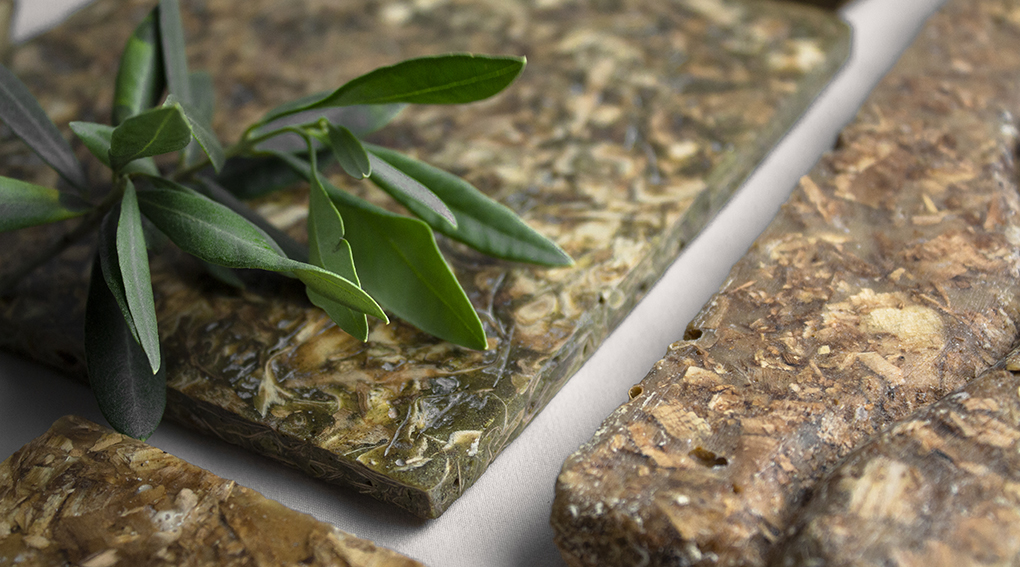
Ulïètu
Francesca Dalosio, MA Industrial Design
Ulïètu is a collection of surface panels reflecting the traumatic effect of xylella fastidiosa, one of the most dangerous plant-pathogenic bacteria in the world. The bacteria dehydrate trees causing leaf scorch, wilt, die-back and ultimately plant death.
The bacteria is spread by the spittlebug which can fly long distances, reaching almost 1.4 km in a single flight. According to the European Food Safety Authority, 563 species are susceptible to infection. Xylella bacteria started spreading in southern Apulia, Italy in 2013, caused by the importation of an infected Costa Rican coffee plant in that area. Since then, half of the Apulian olive trees have died of xylella, precisely 21 million trees.
This project presents a sustainable use for these wood chips, avoiding combustion and taking advantage of the material residual properties in large-scale contexts. This preserves what remains of the Apulian olive trees, giving them a second chance of life. Ulïètu represents a traumatic loss but also a rebirth.
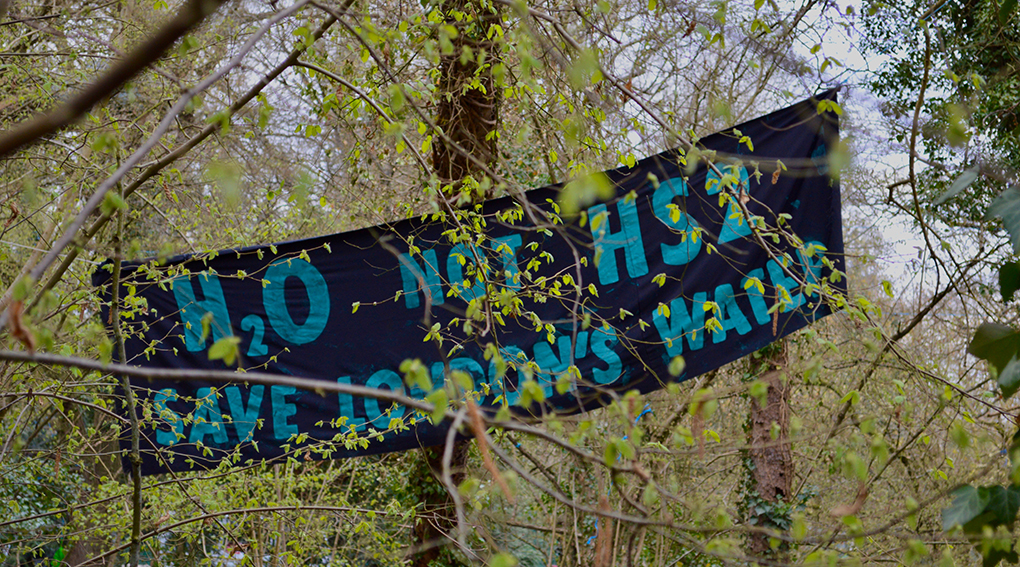
HS2 Ghostlands
Gwen Siôn, BA Fine Art XD
HS2 Ghostlands is a multi-disciplinary project created in response to the climate emergency and HS2, highlighting issues of deforestation, habitat destruction and biodiversity loss. This project is the result of working on location at 18 specific sites over a five-month period collecting field recordings. It forms extensive research into HS2 and its environmental impact – the permanent destruction of 108 ancient woodlands and wildlife habitats.
The music piece combines the environmental audio recordings with original musical compositions. These were created in response to the spaces using the hand-built instruments as well as original vocal, multi-instrumental and electronic compositions inspired by reading the visual landscape of the woodland as a musical score and echoing patterns in birdsong.
By creating instruments from fragments of the landscape such as fallen branches, the musical compositions are not only framed by the sounds of the woodland in the field recordings, but are also made from the sites themselves. They literally resonate through the dead wood of these locations.

Liǎn
Jann Choy, BA Graphic Communication Design
Liǎn (脸) is an experimental mask that explores the relationship between our online personas and offline selves. The concept and design are heavily inspired by Chinese face-changing opera art and online avatars. It merges my cultural tradition with modern technology.
变脸 (biàn liǎn) directly translates to “face changing”; “变”(biàn) meaning “change” and “脸” (liǎn) meaning “face”. The performer changes their face – a silk mask – with a sweep of the hand or a quick turn of their head. This change signifies a shift in moods, while each face symbolises a different emotion. It’s a performance full of suspense, intrigue and mystique. This parallels our online behaviours; we wear many faces online and can change them at any moment.
Liǎn responds to your real-time online emotions using code and soft robotics. Sentiment analysis, a form of machine learning or artificial intelligence, is performed on your online interactions. If you post, like or comment with something positive, it’ll return a positive score, inflating the part of the mask that represents a positive front. Conversely, if it’s negative, it’ll inflate the corresponding area.
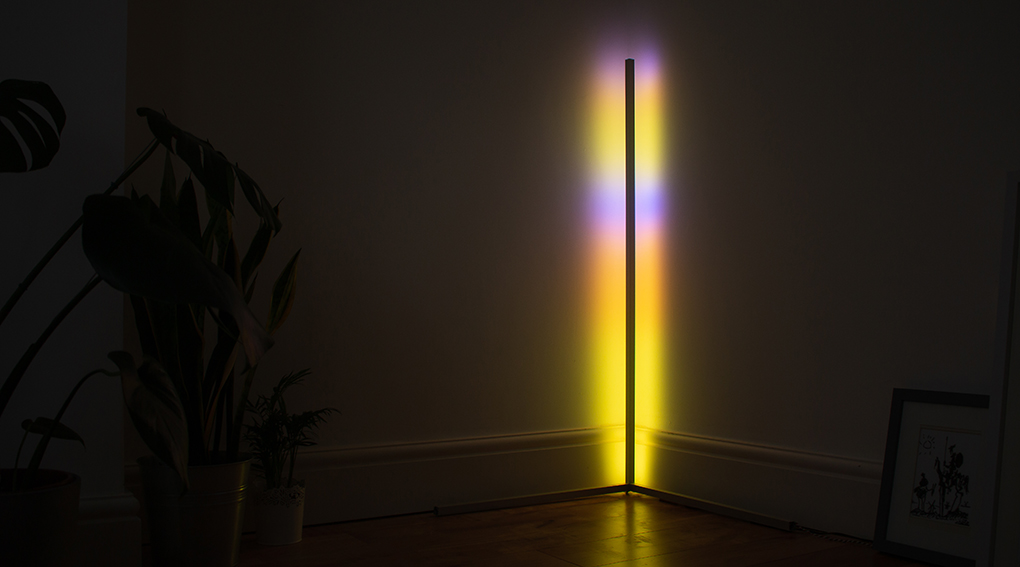
Song Light
Jessie Zhang, BA Graphic Communication Design
An exploration of alternative relationships, Song Light is an ambient lighting system controlled by birdsong that aims to reintroduce nature into our technological lives. Powered by a convolutional neural network trained on the song of 88 bird species commonly heard in the United Kingdom, it amplifies their voices by expanding their song from the auditory to the visual realm.
Each species of bird is represented by a unique colour. As songs of different birds are heard, the colour of the light responds; the more diverse the song, the more colourful the light. Bluer hues promote relaxation and calmness, and thus it is these colours that Song Light produces when it hears birdsong. Contrastingly, when the absence of song is detected, Song Light begins to veer towards the redder hues, red being the colour of warning. The longer the absence, the redder the light becomes.

Speculative Mind Mulch
Kaius Mowbray, BA Fine Art XD
My work is cross-disciplinary, rooted in the idea of fiction as a medium and continuous practice across multiple fronts. Principles of collaboration and cross-pollination are employed to create expansive narrative works that respond to both personal and external crises in meaning, narrative breakdown and the notion of divergent truths – which is highly prevalent in today’s media landscape.
A shifting lens zooms in and out of different characters and “worlds”, presenting fractured stories through animation, writing, sound and illustration. The notion of alternative realities and speculative futures is toyed with in the form of world building. This is explored through the presentation of an alternate London, inspired by high and low cultural forms, as well as my own personal experiences and memories.
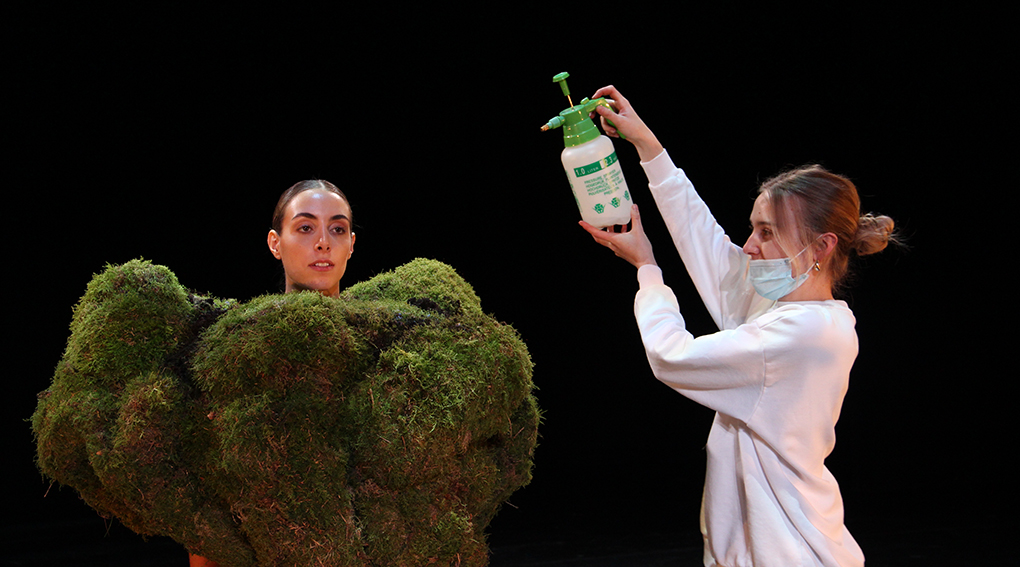
FEN (Growing Garments)
Lydia Hardcastle, BA Performance: Design and Practice
This project has taken me on a wonderful journey. It began when I successfully grew cress seeds in cotton wool during lockdown. I wondered if I could incorporate this concept in a costume.
After months of experimentation, I found the perfect material and environment in which cress can thrive. I then created a knitted garment and grew over 25,000 cress seeds in it. It was not only texturally beautiful, but the smell and wet feel of the cress and its roots mesmerised me. This became more than just a visual costume – it was a sensory experience. It began an astonishing journey for me, where I started to understand the importance of nature to our mental health, and people’s in/accessibility to green spaces during lockdown.
There’s a huge level of unpredictability when using materials which are alive and that will die if not tended to. This project gave me such a sense of purpose during lockdown, and positively impacted my mental health. As a result of this, I created a costume smothered in foraged forest moss, inspired by a garden snail.
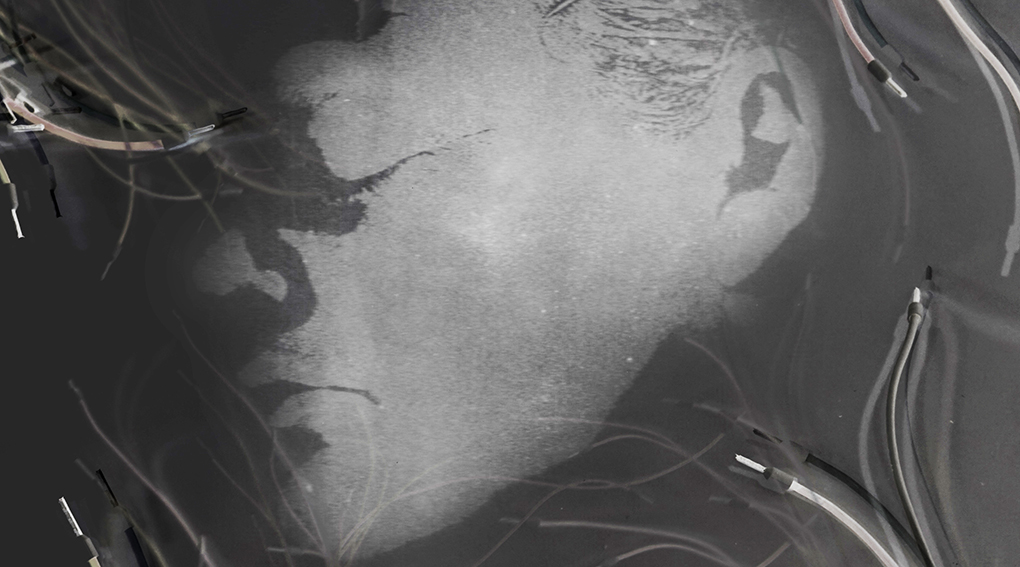
We Are All Carbon
Molly Macleod, MA Art and Science
What happens if we inhabit our technological future with our own biological matter?
For We Are All Carbon, my own biological matter is repurposed to amplify sound. One year’s worth of hair and nails, shed and collected, are cremated to form carbon granules. Vibrations passing through these granules create a transducer that converts electrical signals into sound.
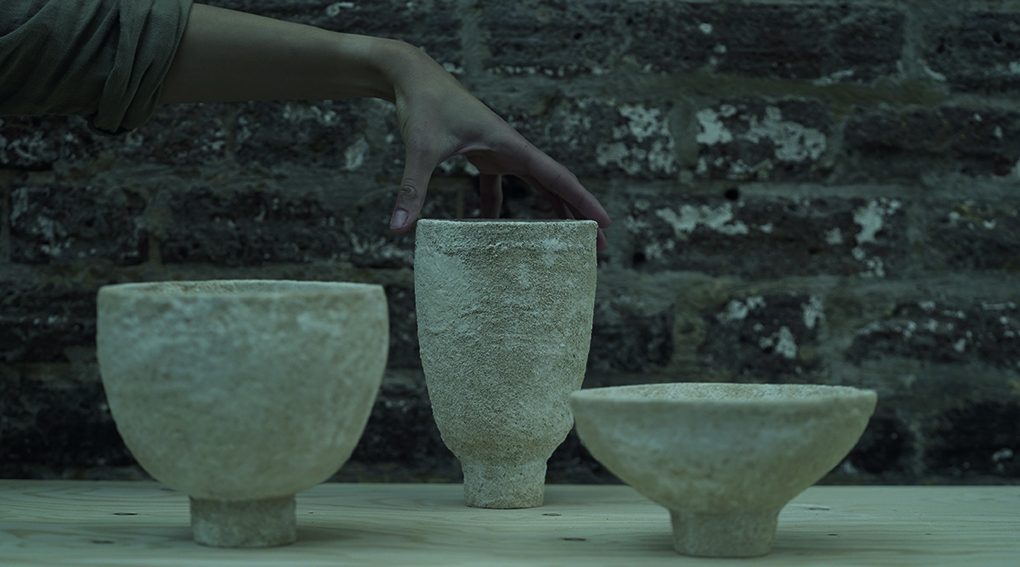
BacTerra
Nikoleta Crysikou, MA Material Futures
BacTerra is a project proposing the use of bacteria to create alternative ceramics that are self-fired and biologically glazed. By providing a making process where ceramic waste and living organisms are my main ingredients, I hope to start a conversation about the promising possibilities of biotechnology within pottery.
Pottery is a universal craft that has endured for thousands of years. But while people have mastered this craft and optimised the material, its production method has remained relatively unchanged. It’s currently seeing a huge surge in popularity as a creative and harmless escape from the stresses of contemporary life. But if we unpick every aspect of ceramics, we identify quite a few problematic areas. One of them is the energy-consuming and carbon-heavy kiln-firing process. What if we could find alternative ways of creating ceramics: ceramics that don’t require kiln firing; ceramics made by living organisms and biological processes?

Co-Obradorio Galego
Paula Camina, MA Biodesign
Co-Obradoiro Galego is a collaborative project between me and three basket makers, working together in a local context in Galicia.
Galicia is a region in northwest Spain bathed by the Atlantic Ocean. The Atlantic Ocean has supplied the Galician and Spanish populations with food throughout their history, originating 602 tonnes of seafood exoskeleton waste every year, which is a danger to the environment and human health. Moreover, this situation has increased in recent years due to fishing tools moving away from traditional fishing crafts. Traditional fishing tools were made by local basket makers with wicker or wood, but today are made mainly from plastic by large foreign industries. This decline in basketry has intensified because of the reforestation of non-autochthonous species whose wood can’t be used for basketry, and the disappearance of rural life.
Therefore, my objective is to develop a flexible and biodegradable bio-material from Galician seafood exoskeletons (unused waste) to help regenerate our Galician craft heritage. With this biodegradable material, we send a message about the permanence of the Galician basketry technique, the basket weavers and Galician culture through a material that disappears but reactivates the Galician economy.
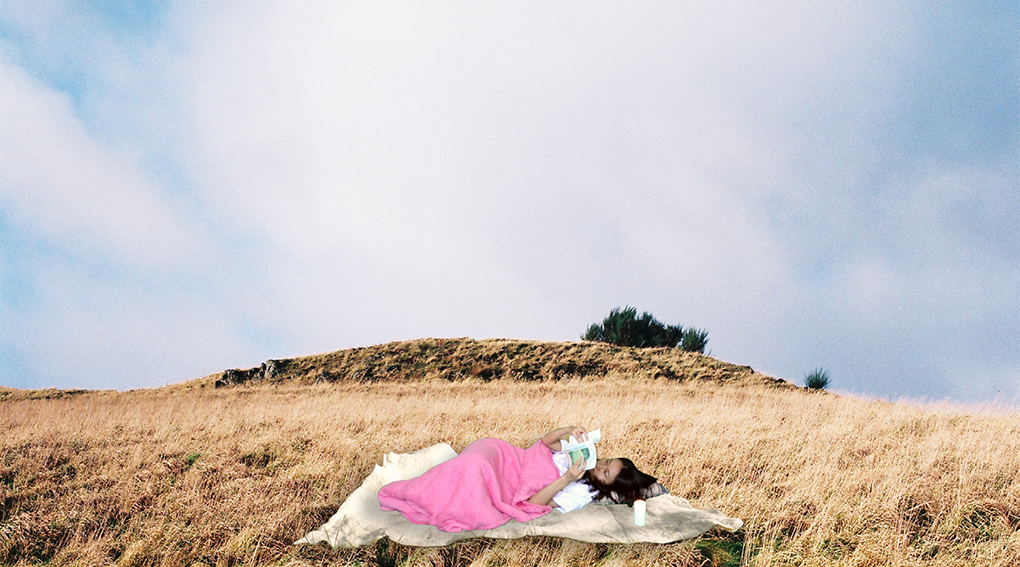
Homes on the Move
Yijia Wu, BA Fine Art 4D
I’m a Chinese visual and performance artist currently based in Beijing. My personal experience of drifting from place to place has raised my awareness of self-identity. My practice discusses the nomadism and the sense of dislocation I’ve experienced over the years. I use moving image, performance and installation as tools to explore the possibility of translating the experience of drifting and “unsettling” into a visual language.
The rapidly developing city drives many individuals to become “city nomads”, including me. The contrast between the settlement of nomads and the “unsettlement” of migrants drives me to explore notions of territory and home, as well as to examine the relationship between people and land.
I identify myself as a nomad travelling across time and space. Most recently, I used my body as the medium to explore the boundaries between public and personal/domestic space and the impact of the government’s policy on individuals. By performing in Beijing’s public places with a range of cultural and historical backgrounds, I interrogate who has the power to determine one’s space while exploring and expanding the definition of home, territory and sense of belonging.

Planet Series
Yuhan Huang, MA Fine Art
My work focuses on the influence of online derivatives on social lifestyles and communication methods in the development of online culture. These online derivatives include social media, short video apps and barrage websites. In the contemporary network environment, how can text and images break through algorithms and data visualisation, and get rid of network cybernetics?
In my work, words and images have found their own breakthrough methods. This information is hidden behind the internet, and their time to appear is fleeting. Even though they’re small, trivial and ordinary, they’re all worth remembering.
I want viewers to feel the power of tiny data in the forgotten space. They slowly explore the massive amount of information in this dim space to witness the people, time, places and events behind the information. People feel their own insignificance in the face of a huge amount of historical information on the internet; but they also discover the huge energy of small things condensed together.
This article was originally published on Campaign Magazine
